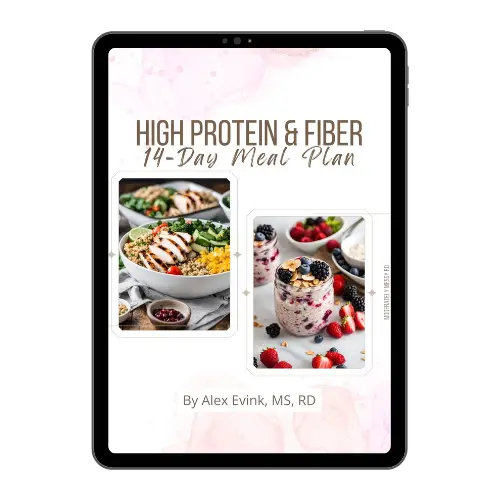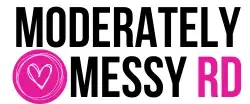Let’s dive into the advantages of embracing a diet high in protein and fiber – my two favorite nutrients! This post will discuss how they can impact your health, with 3 high protein, high fiber meal plans tailored to boost both protein and fiber consumption.

I’m very passionate about this particular subject because there is a vast amount of research to support it. Understanding the positive effects of integrating more protein and fiber into your diet can be a powerful motivator to actually make healthy lifestyle changes.
Feel free to use these meal plans as a guide, and adapt them to suit your preferences and lifestyle!

How Much Protein Do We Need Per Day?
Most active, healthy adults should aim to consume about 1.2-1.7 grams of protein per kilogram of body weight. Ideally, protein should be distributed relatively evenly throughout the day for optimal muscle protein synthesis, digestion and absorption.
Not only that, but meals that contain 20-30 grams of protein ensures meal satiation and satisfaction.
For example: 150 lb./2.2 = 68 kg x (1.2-1.7) = 81.6-116 grams of protein per day.
To reach 116 grams of protein per day, aim for meals with 30 grams of protein and snacks with about 10-15 grams of protein.
How Much Fiber Do We Need Per Day?
The recommended amount of fiber each day is about 14 grams for every 1,000 calories, or 25 grams each day for women and 38 grams for mean.
It doesn’t sound like a lot, but most people are not meeting the minimum amount of fiber daily!
If you’re just starting to consume a diet higher in fiber, it is best to start low and go slow. Gradually increase the amount of fiber you’re eating over the course of a few weeks to prevent digestive discomfort, like bloating, constipation and abdominal pain.
It’s also very important to drink a lot of water, as fiber absorbs water and helps to soften stools and promote bowel regularity.

Related Posts:
— 8 Strategies to Help Improve Gut Health
— 1600 Calorie High Protein Meal Plans
Benefits of Consuming a High Protein, High Fiber Diet
Where do I even begin with all the benefits of consuming a diet high in protein and fiber? Let’s go over just some of the benefits of a high protein, high fiber diet.
Weight Management
Dietary fiber and protein help to increase feelings of fullness after we eat a meal. Therefore, if we prioritize protein and fiber we’re less likely to turn to convenience foods or processed snacks, which may decrease overall caloric intake and help to maintain a healthier lifestyle.
Several clinical studies have found that consuming more than the recommended daily allowance of protein can help to reduce body weight and decrease fat mass. It can even help prevent weight regain after weight loss.
Even further, when in a calorie deficit, eating a higher protein diet helps to preserve lean muscle mass – which can affect the number of calories we burn at rest.
Blood Glucose Control
Together, both protein and fiber help to slow the absorption of blood glucose by delaying how quickly our food is broken down, resulting in lower blood sugar levels and decreased blood sugar spikes.
A high fiber diet can reduce fasting blood glucose and Hgb A1C, and is encouraged as a diet strategy for those with Type II diabetes.
Gut Health and Immune Function
Not only does fiber promote bowel regularity, but the fermentation of fiber in our gut creates short-chain fatty acids, which plays a role in our immune function and helps regulate inflammation.
Fiber has been shown to increase microbial diversity, while also acting as a prebiotic – which is the food for the “good bacteria” probiotics.
Additionally, there’s new evidence that a higher protein diet may impact intestinal microbiota composition. However, further research is needed to understand the link between protein and gut health.
For more information, read increasing fiber intake to improve gut health.
Lower Risk of Chronic Diseases
Consuming a diet adequate in fiber has been linked to a decreased risk of certain diseases, like cardiovascular disease, Type II Diabetes, colon cancer, diverticulitis, and breast cancer!
When it comes to protein, plant-based sources as well as fish high in omega-3 fatty acids (like salmon) also have the potential to lower disease risk.
High Protein, High Fiber Meal Plans
3 sample high protein, high fiber meal plans with macronutrient breakdown included.
Use these as a guide, and customize based on your preferences and lifestyle!
Nutritional information is just an estimation, and individual ingredients and preparation may lead to discrepancies. Calories are on the lower side, as we often underestimate them – leaving room for any add-ins.
Meal Plan #1: 1,656 calories, 100g protein, 161g carbs, 33g fiber
Breakfast:
Chia Breakfast Bowl; 400 calories, 22g protein, 41g carbs, 15g fiber.
This recipe contains Greek yogurt to increase the protein, and the tiny but mighty chia seeds which are a great source of fiber. This recipe itself already meets over half of the recommended daily fiber intake.
Lunch:
Meal Prep Southwest Chicken Burrito Bowl (Jar of Lemons); 415 calories, 37g protein, 49g carbs, 8g fiber.
This recipe is easy to meal prep – so you have lunch already made for a few days! High in protein and fiber.
Dinner:
Salmon Quinoa Bowl (Stephanie Kay Nutrition); 566 calories, 33g protein, 39g carbs, 5g fiber.
I had to include salmon in this first meal plan, as it is one of few foods high in omega-3 fatty acids DHA and EPA. It’s also low in mercury, and safe for pregnancy and breastfeeding!
Snack:
Apple slices with 2 Tbsp. peanut butter: 275 calories, 8g protein, 32g carbs, 5g fiber.

Meal Plan #2: 1,719 calories, 114g protein, 133g carbs, 28g fiber
Breakfast:
Cottage cheese (1/2 cup) scrambled eggs (2), with whole wheat toast and avocado slices (1/2 avocado); 361 calories, 22.4g protein, 20g carbs, 4.4g fiber.
Since eggs only contain 6 grams of protein each, adding cottage cheese can add some additional protein and creaminess.
Lunch:
Grilled Chicken Salad (Well Plated by Erin); 630 calories, 38g protein, 32g carbs, 12g fiber.
This recipe is PACKED with flavor and nutritious fruits and vegetables: strawberries, spinach, romaine lettuce, avocados and topped with nuts.
Dinner:
Tofu Rice Bowl with Greek Yogurt Bang Bang Sauce; 478 calories, 35g protein, 53g carbs, 7g fiber.
To prioritize plant-based protein sources, try this tofu rice bowl with a bang bang sauce made with Greek yogurt to up the protein. The tofu is baked until crispy so the texture isn’t as off-putting if you’re not used to tofu.
Snack:
Greek Yogurt (1/2 cup) topped with raspberries (1/2 cup) and sunflower seeds (4 Tbsp.); 250 calories, 19g protein, 28g carbs, 5g fiber

Meal Plan #3: 1,595 calories, 124g protein, 153g carbs, 31.6g fiber
Breakfast:
Berry Cheesecake Overnight Oats; 376 calories, 37.4g protein, 41g carbs, 8.6g fiber.
Overnight oats are simple to prep ahead for busy mornings, and can be customized in so many ways. The chia seeds make these high in fiber, while the Greek yogurt and protein powder increase the protein content.
Lunch:
Hearty Vegan Lentil Soup (Simple Veganista); 269 calories, 15g protein, 53g carbs, 10g fiber.
8 ounce glass of skim milk; 90 calories, 9g protein, 13g carbs, 0g fiber
Lentils are an excellent plant-based protein source (and a good source of fiber). Another recipe to prioritize more plant-based protein.
Dinner:
Buffalo Chicken Crockpot Pasta; 550 calories, 44g protein, 50g carbs, 10g fiber.
The sauce is made creamy by combining whipped cottage cheese and buffalo sauce. The Barilla protein+ noodles at 10 grams of additional protein per serving!
Snacks:
1/4 cup of pistachios: 160 calories, 6g protein, 8g carbs, 3g fiber.
2 Hard-Boiled Eggs: 150 calories, 13g protein, 1g carbs, 0g fiber.

Want a Meal Plan High in Protein & Fiber?

If this post resonates with you, I created a 14-day meal plan high in protein and fiber with 20+ recipes and grocery lists! Breakfast, lunch, dinner and snacks. Take all the guess work out of it and give it a try for stress-free meal plan and prep so that you can use these principles your entire life to reap all the benefits. It’s only $5!
Tips to Increase Protein and Fiber Intake
- Incorporate beans and lentils: they’re a good source of both protein and fiber.
- Add seeds: chia seeds are a great source of fiber, while hemp hearts are high in protein. They can be added to salads, smoothies, oats, soups, and yogurt.
- Utilize Greek yogurt and cottage cheese: Increase the protein content of meals by replacing mayo or cream with one of these substitutes – this is especially helpful when selecting more plant-based meals.
- Choose fruits or vegetables for snacks.
- Compare food labels of different products.
Additional Thoughts
These meal plans aren’t “perfect” – but they provide a good foundation on how to incorporate more high protein, high fiber foods into the diet.
By adapting some of these eating habits, you can build confidence, manage your weight, feel good about yourself, and potentially lower your risk for chronic diseases.
Do I get 25 grams of fiber in my diet every day? Probably not, but I understand what I need to do to make that happen – and I am more aware of what I should be eating.
If you’re interested in more moderately messy content – where it’s not about perfection but about striving for more balance and order – sign up for my newsletter for infrequent updates!

I just purchased the 14 day protein meal plan and put in the wrong email. Is it possible for you to send to me.
Yes, just sent! I received an email that it failed to send. Thanks for the purchase!